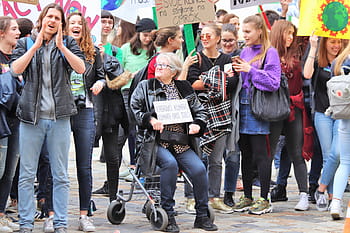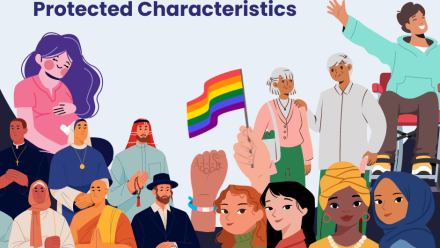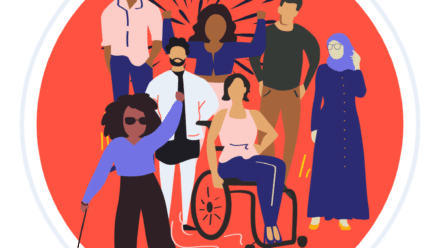The disabling effects of climate change
19th August 2020 by Ellie Thompson
Climate change affects all of us in many complex ways- from extreme weather, to increasing frequency of natural disasters, to the destruction and extinction of wildlife across the world. But although we perceive climate change primarily as an environmental issue, it’s important to note that it’s a social crisis, too. Climate change and related phenomena may affect us all, but there is a disproportionately negative effect on people who already experience disablement and disadvantage in our society.
For disabled people, the effects of climate change are more significant, severe and life-threatening than they are for non-disabled people.
For example, perhaps the most common and pervasive effect of climate change is extreme changes in weather. Of course, no one feels comfortable in extreme hot or cold weather. But for many people with chronic illnesses, pain, or health conditions, even the most minor changes in weather can mean the difference between a good day and a bad day- but extreme heat or cold can trigger complete debilitation, or even life-threatening declines in health.
For our team member Molly, who has multiple chronic pain conditions, extreme weather makes it impossible for her to leave the house: “As I have Complex Regional Pain Syndrome and Fibromyalgia, I am temperature sensitive, meaning cold weather is absolutely freezing and hot weather is like fire. When the weather is particularly cold or rainy, my body feels like all my bones are frozen, my skin goes pale and it’s incredibly painful- going outside feels like the Antarctic. When it’s hot it feels like I have so many layers of clothing on that I can’t take off, I experience severe swelling and touch hypersensitivity, I feel debilitating pain and disorientation and often faint.”
Furthermore, global health issues, although threatening to us all, also have a more serious impact on disabled people. For those who are immunocompromised or have reduced lung capacity, air pollution can have a disastrous effect on our already compromised health. We are at greater risk of contracting infectious diseases, either due to compromised immune systems or because sanitation measures and controls may be inaccessible to us. And when natural disasters strike, disabled people are again particularly vulnerable. Emergency evacuation measures can fail to take into account people with limited mobility or access requirements, and for some even the act of being displaced from a safe and accessible home environment can be deadly. It has been reported that disabled and vulnerable people were extremely disproportionately affected by Hurricane Katrina due to the inaccessible transport used for evacuation, communication methods excluding those with visual or hearing impairments, and abandonment of people who needed support to understand and react to the crisis.

Image description: A street completely submerged due to flooding- only the roofs of the houses are visible
Finally, even popular methods to combat climate change often prove inaccessible, or even dangerous, to disabled people. For example, the popular movement to ban plastic straws may seem a no-brainer in reducing single-use plastics but for many disabled people, straws are not just a convenience, they’re a necessity in ensuring they can safely drink or even take vital medicines. Adapting your diet to reduce emissions is a really important step, but it’s crucial we remember that such diet changes may not be possible for people with chronic illnesses that impact digestion, those with learning differences who rely on safe comfort foods to stay nourished, or people with mental illnesses (particularly people with eating disorders). And measures to limit the use of cars and encourage people to take up public transportation instead are of course important, but if public transport remains inaccessible to disabled people then all these changes do is add even more barriers into our daily lives.
What can we do?
Disabled people need to be a part of any conversation about combating climate change. For non-disabled people fighting climate change, it is vital that you keep disabled people in your minds and your campaigns: make sure your protests are accessible to all, your communications don’t exclude people with learning differences or sensory impairments, and your solutions don’t disproportionately affect disabled people.
For disabled people, we must take any opportunity we can to make our voices heard.

Image description: A person sitting on their walker holding up a sign during a climate change protest.
How we can all ensure the revolution is accessible
- For everyone, including non-disabled people: when you hear about or sign up to attend a protest, ask the organisers what steps they have taken to ensure the demonstration is accessible. Are there safe quiet spaces to stand? Is the route accessible and step-free? Are there toilet facilities available, and are they accessible? If there are speakers or performances, is there a sign-language interpreter?
- If protests or demonstrations are not accessible: send letters or call your MP or local representative, share information and resources on social media, sign and share petitions, read up on issues and share what you learn, donate to existing groups if you can
- Research companies that you use for their climate change practices. If they’re lacking, contact them to demand more. If they don’t respond, boycott them and research better alternatives.
- Take part virtually through attending virtual demonstrations, or webinars arranged by activist groups
- Find local groups to get involved with, so you can make sure you’re included in the conversation and are a part of a community dedicated to affect change that works for all of us.


